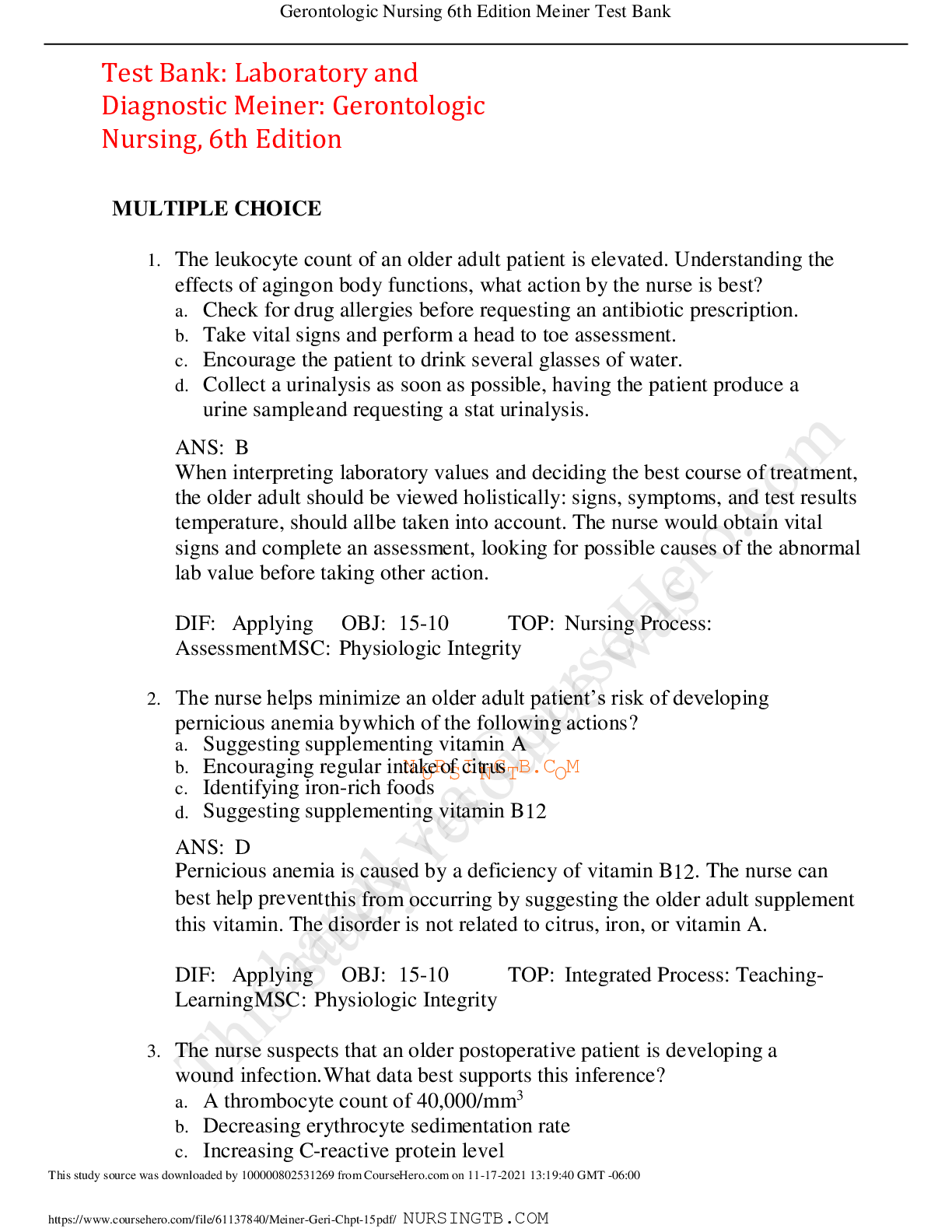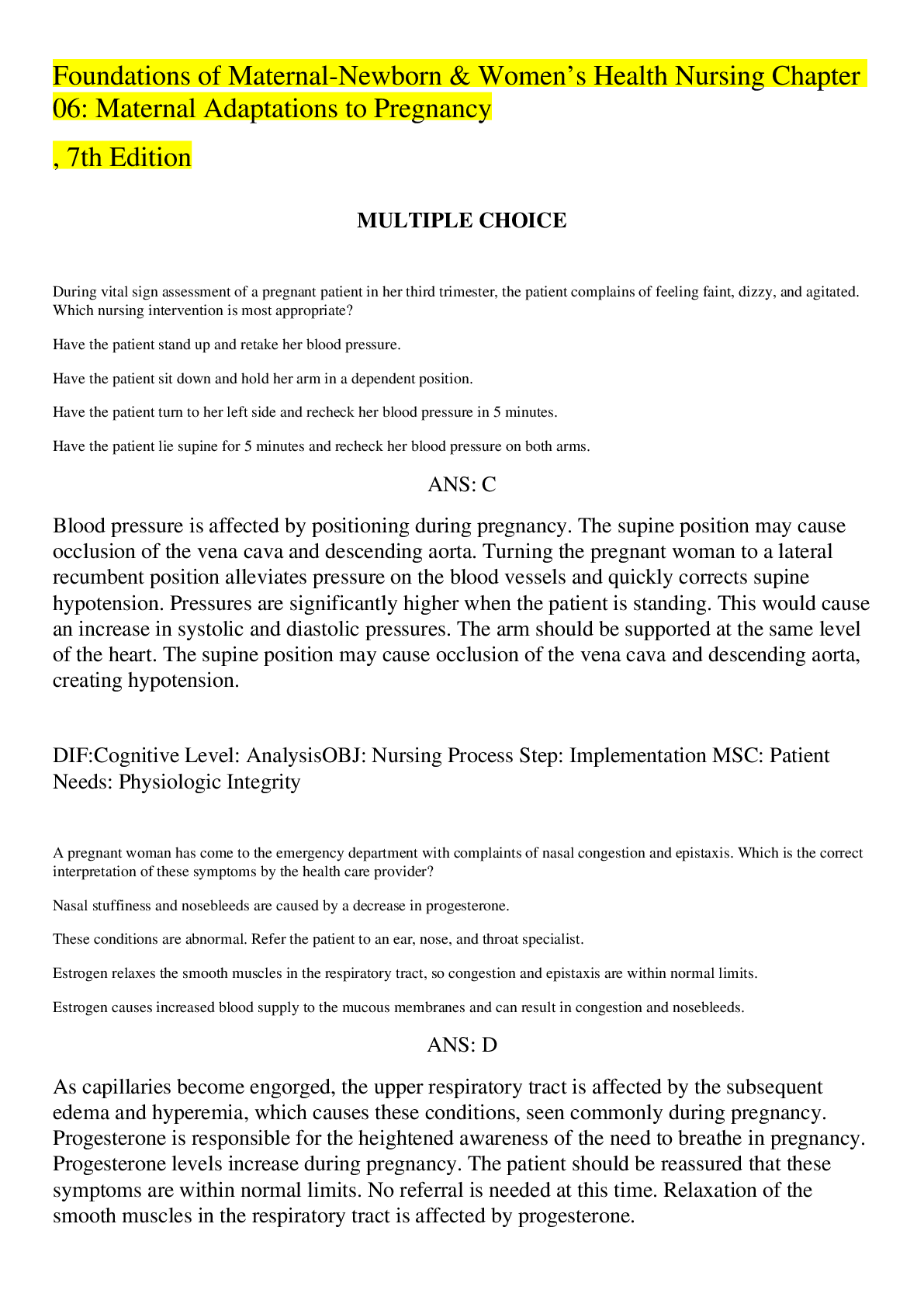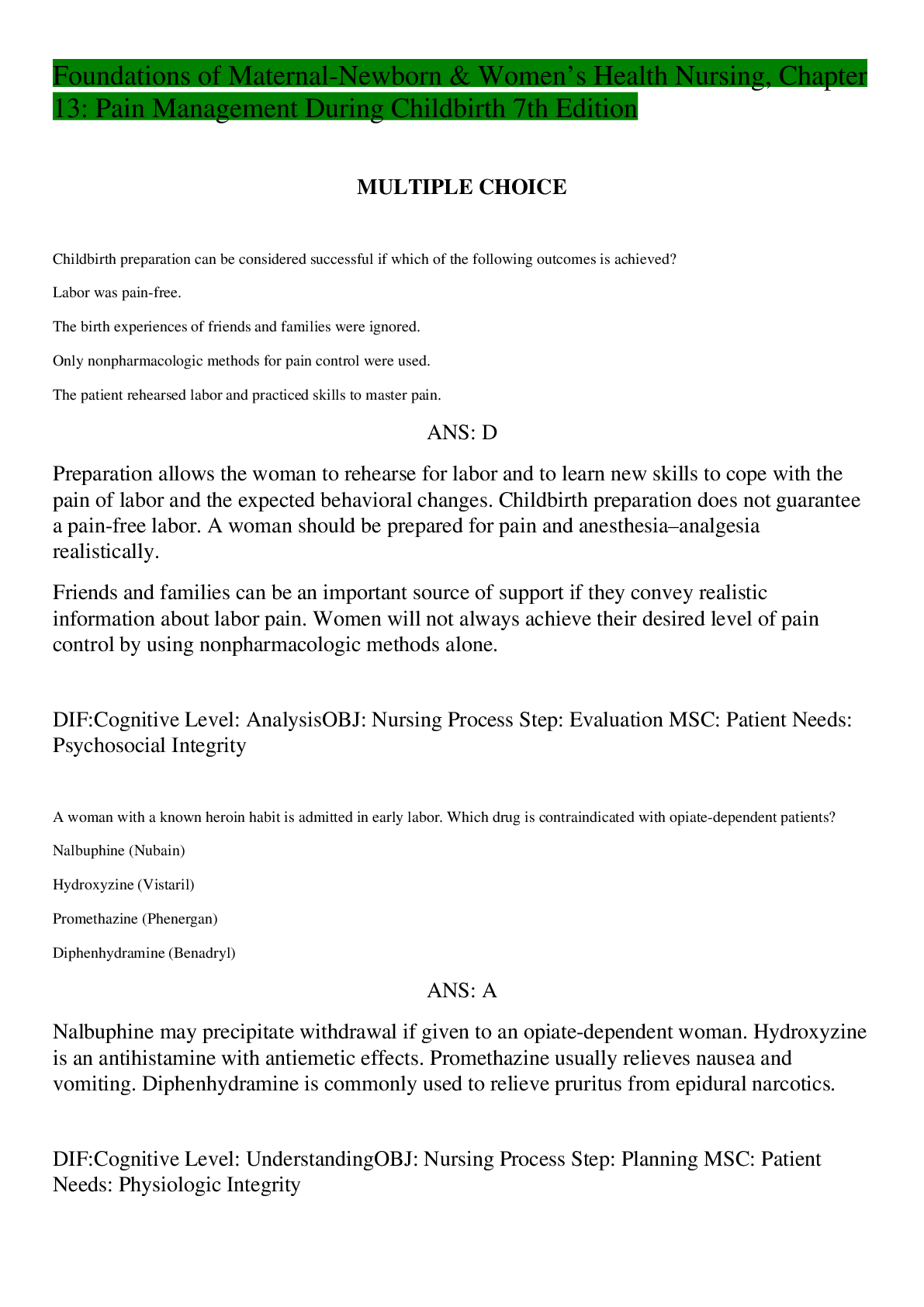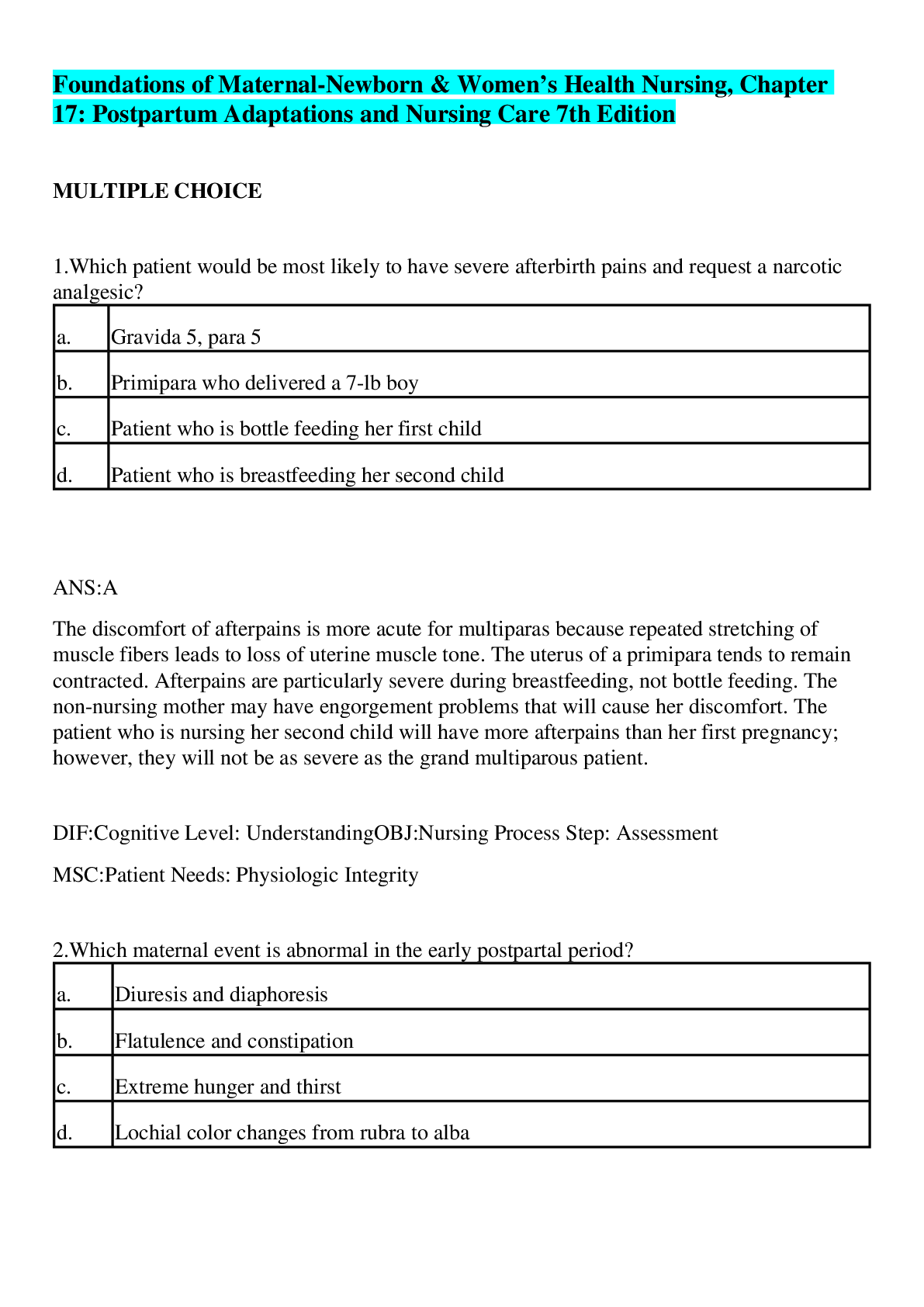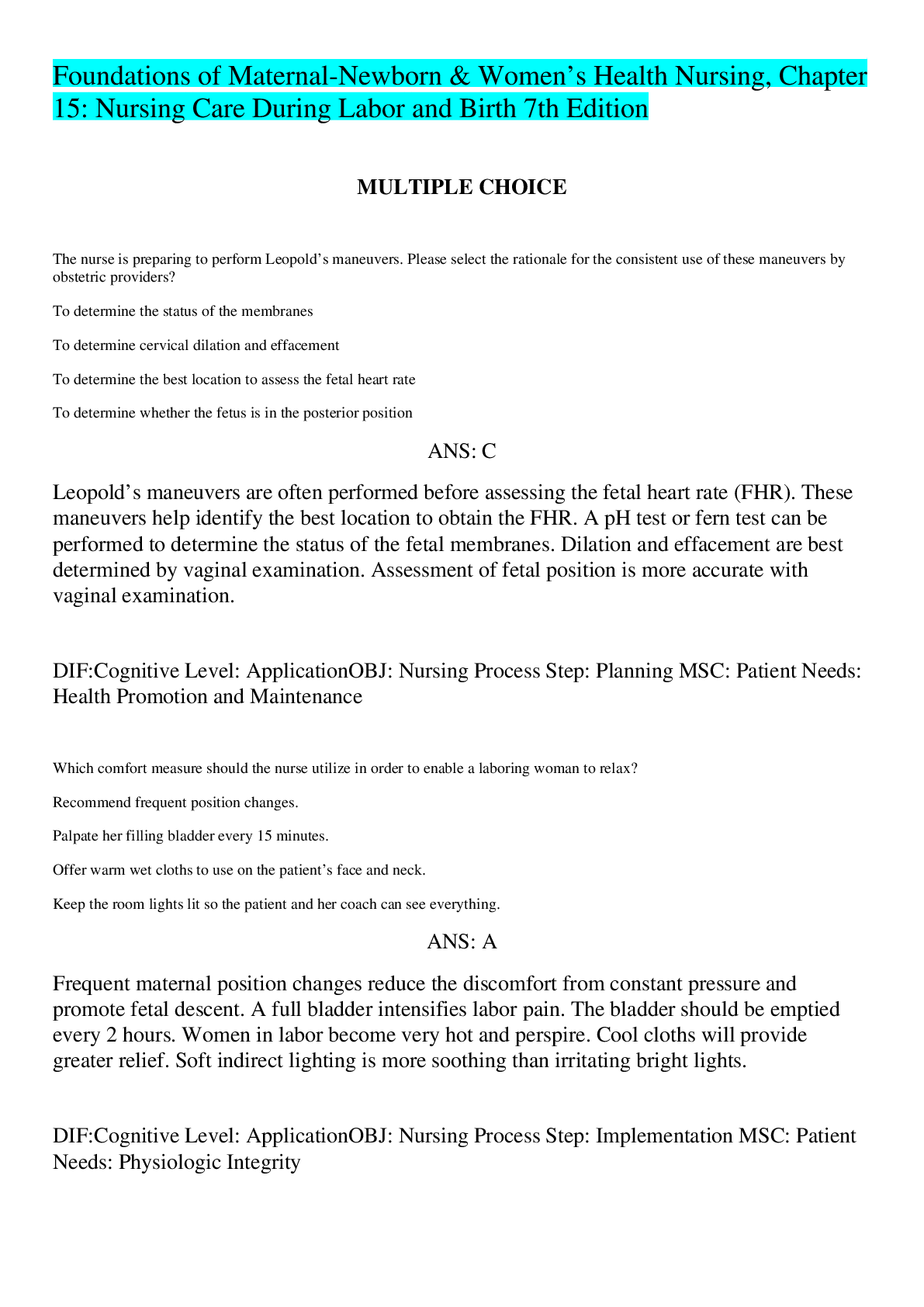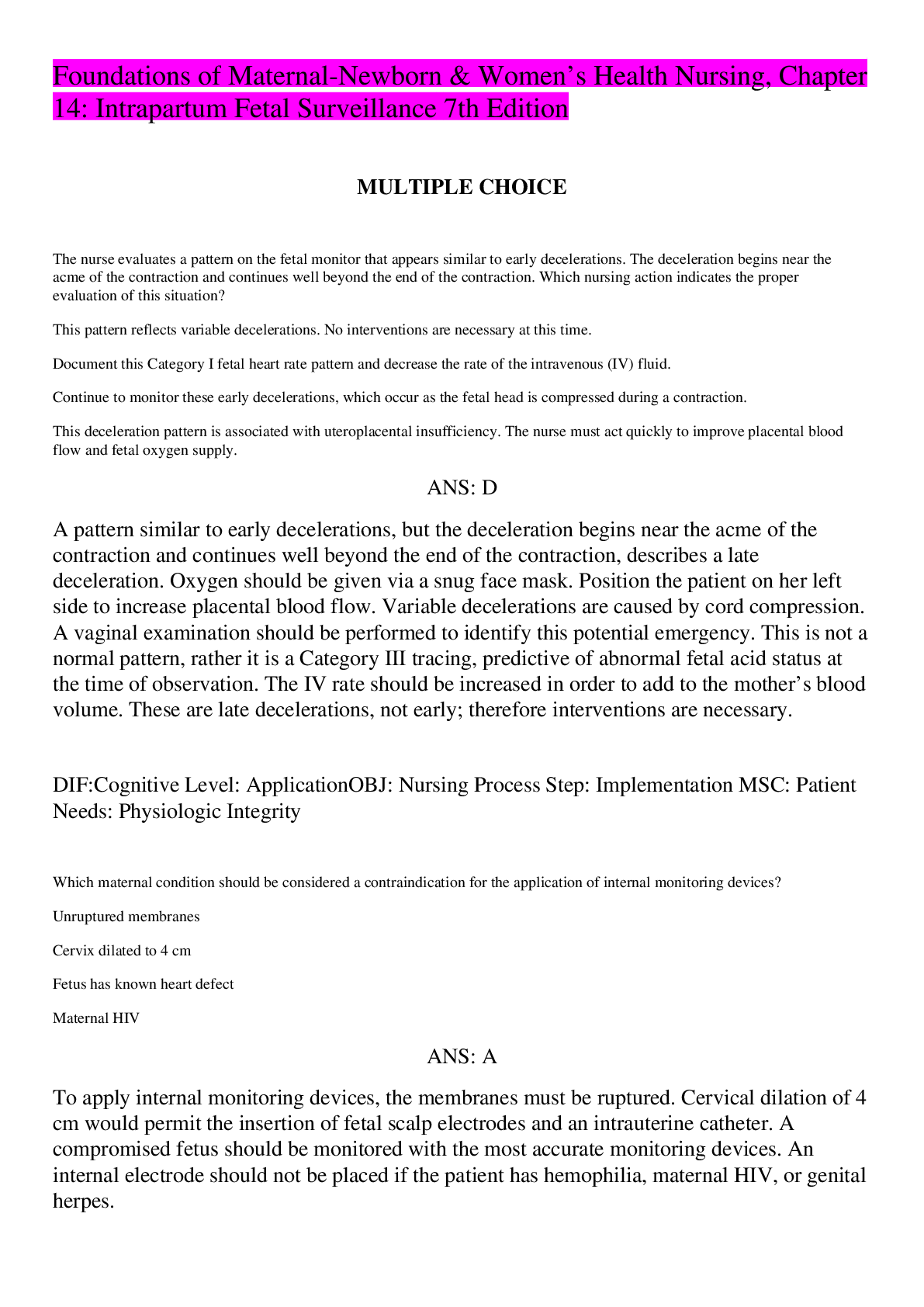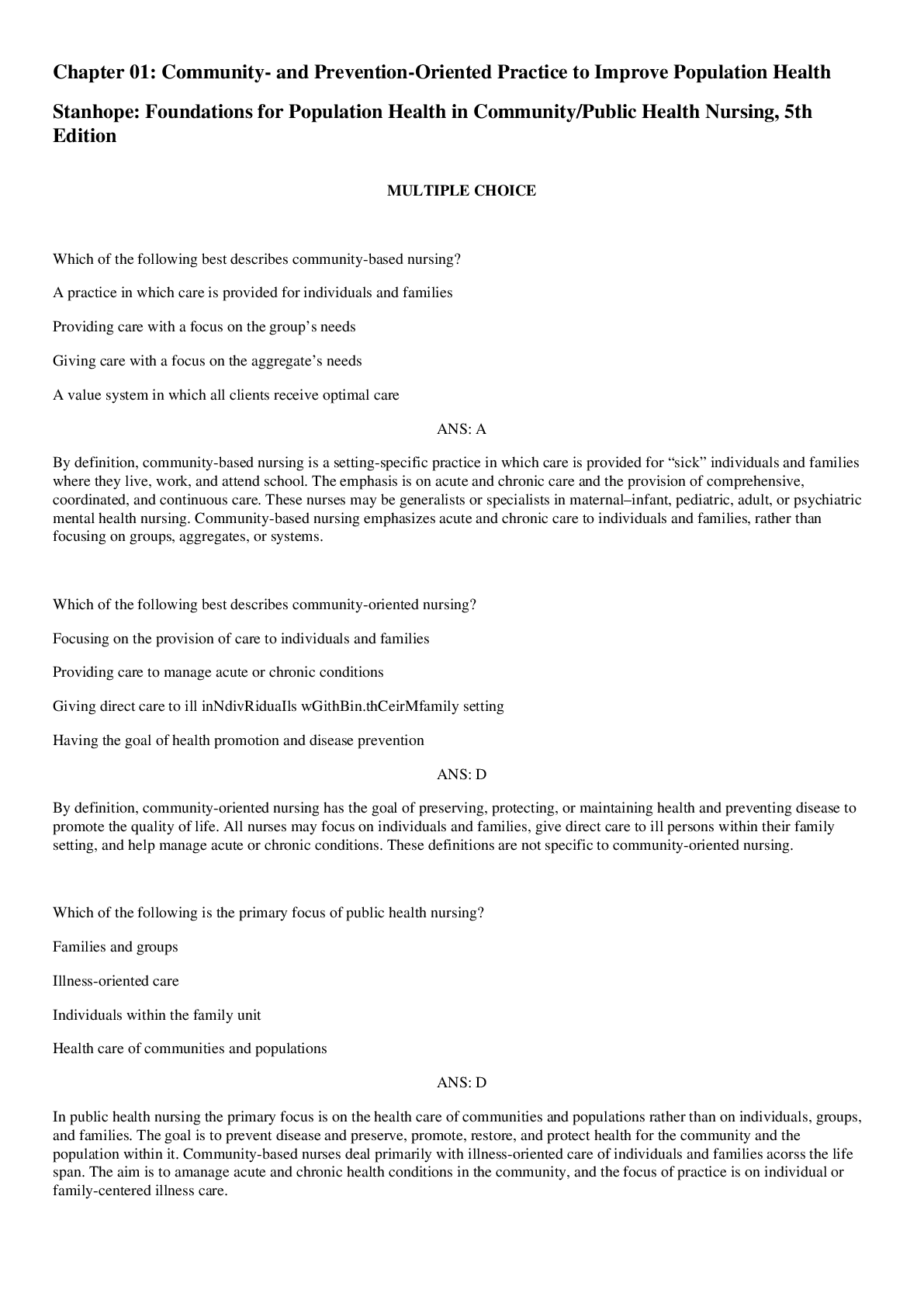*NURSING > TEST BANK > Test Bank Health in the Global Community Nies: Community/Public Health Nursing, 7th Edition,100% COR (All)
Test Bank Health in the Global Community Nies: Community/Public Health Nursing, 7th Edition,100% CORRECT
Document Content and Description Below
Test Bank Health in the Global Community Nies: Community/Public Health Nursing, 7th Edition MULTIPLE CHOICE 1. Which best describes why a nurse working in a U.S. urban area should be knowledge... able about infectious diseases common to areas of Africa? a. Nurses have an ethical commitment to care for others throughout the world. b. Every infectious disease is just one airplane ride away. c. Infection could occur if a nurse goes out in public. d. Nurses meet people who may originally have been born elsewhere. ANS: B Infectious diseases do not recognize or respect country borders. With rapid international travel, an infected person could easily be in any country in a very short period of time. Problems throughout the globe can threaten human life. Although nurses have an ethical commitment to provide care, infections can occur anywhere, and nurses may care for populations who were originally born outside of the United States, the primary need for the nurse to have this knowledge exists because infectious diseases can spread throughout the world in a very short period of time because of the ease of travel in the world. DIF: Cognitive Level: Understand (Comprehension) 2. Which is one of the biggest threats faced by developing countries that are trying to grow economically and make a better life for their citizens? a. Lack of education and knNowlRedgIe G B.C M b. Political unrest c. Environmental hazards d. Large population ANS: D U S N T O Large populations create pressure. In developing countries, famine, trade problems, and war may occur. Malnutrition, disease, or death may result. The poor suffer excess mortality and morbidity. Quality of life is less. Overcrowding leads to pollution, stress, disease, and violence. Each of these challenges represents a major barrier to economic growth. Thus, the large population can cause there to be problems with lack of education, political unrest, and environmental hazards. DIF: Cognitive Level: Understand (Comprehension) 3. Which group makes up about 25% of the world’s population? a. Children b. Elderly c. Teenaged adolescents d. Caucasians ANS: A According to the World Health Organization, in 2013, 26.1% of the world population consisted of children and 8.3% of the population were over age 65. The percentage of teenaged adolescents and Caucasians is not reported in the text. DIF: Cognitive Level: Remember (Knowledge) 4. Which has been a common result in countries with a severe HIV/AIDS epidemic? a. Life expectancy dropped to 35 to 40 years but is slowly increasing. b. Free clinics have begun distributing condoms to stop the spread. c. International aid has begun to lower the infection rates. d. Missionaries are establishing orphanages within their churches. ANS: A In countries severely affected by the HIV/AIDS epidemic, life expectancy dropped to 35 to 40 years. However, life expectancy has significantly improved over the last decade. International aid, orphanages, and condom distribution may be present in these countries; however, the main problem was decreased because of this epidemic. DIF: Cognitive Level: Understand (Comprehension) 5. A public health nurse is partnering with a local community agency to create a media campaign focusing on prevention of teenage pregnancy. Which is a key component of the Integrated Model of Sustainability and Innovation that should be implemented? a. Respect for the population of interest b. One source of reliable funding c. Administrative decision-making d. Effective communication ANS: D An emphasis of the integration of research/discovery, teaching/learning, and practice/service/engagement NwithRnuIrse-Gled Bin.noCvatMion led to the development of the Integrated Model of Sustainability and Innovation (IMSI). The key components of the IMSI include effective communication, collaboration, community partnership, and a mosaic of support or a diverse portfolio of funding sources to promote long-term sustainability of local to global community-based projects. Conversely, unsustainable projects lack clear communication, mutual respect, and a lack of community and administrative partnership and are often dependent on only one or two sources of support. DIF: Cognitive Level: Apply (Application) 6. Most of a country’s citizens have died from malnutrition or as the result of violence. Which conclusion can be drawn? a. Their country has a problem with an adequate water supply for agriculture. b. They live in a country where weather interferes with food crops. c. They live in a developed country involved in a war. d. They live in a developing country. ANS: D Infectious disease and malnutrition are the primary causes of mortality in developing countries. Cardiovascular disease, cancer, respiratory disease, stroke, violence, and traumatic injury are the primary causes of mortality in a developed country. The problem of malnutrition is broader than examining the environment associated with growing the country’s food supply. DIF: Cognitive Level: Understand (Comprehension) 7. Which statement best defines epidemiological transition? a. A change from morbidity caused by a particular infectious disease to a different infectious disease b. A change from mainly infectious diseases to chronic diseases c. A change in infectious diseases caused by a difference in agent, host, or environment d. A change in life spans of various age groups in a specific country ANS: B Many developed countries experienced an epidemiological transition from having an infectious disease profile to having a chronic disease profile and are now plagued by chronic diseases. Once plagued with high rates of infectious disease, developed countries significantly reduce high mortality rates from these diseases through improved sanitation, nutrition, and immunization and improved health care. Most developed countries have a more stable economy and a wide range of industrial and technological development. These countries experience an epidemiological transition. The other statements do not define epidemiological transition. DIF: Cognitive Level: Understand (Comprehension) 8. Which action to reduce tobacco-related deaths and diseases is supported by the World Health Organization (WHO)? a. Raise taxes on tobacco b. Limit tobacco production c. Prohibit the sale of tobacNco R I G B.C M d. Encourage tobacco exportsU ANS: A S N T O In 2003, the first global public health treaty was adopted at the World Framework Convention on Tobacco Control. The treaty was designed to reduce tobacco-related deaths and diseases around the world. In 2008, the WHO introduced MPower, which stands for Monitor tobacco use and prevention policies; Protect people from tobacco use; Offer help to quit tobacco use; Warn about the dangers of tobacco; Enforce bans on tobacco advertising, promotion and sponsorship; and Raise taxes on tobacco DIF: Cognitive Level: Understand (Comprehension) 9. Which strategy should be used to lower the risk of malaria among the world’s population? a. Distribute insecticide-treated nets and antimalarial medications b. Educate people to keep their windows closed at night c. Spray neighborhoods with insecticides to kill any mosquitoes present d. Spread DDT on bodies of water to prevent larva growth ANS: A Effective low-cost strategies are available for malaria’s prevention, treatment, and control, including insecticide-treated nets and new-generation medications. It would be very dangerous to spray neighborhoods with insecticides, which also contaminate food. DDT has been banned in the United States for many years because of its long-term harmful effects on the environment, including food animals. Keeping the windows closed at night is not going to prevent the threat that occurs during other times of the day. DIF: Cognitive Level: Understand (Comprehension) 10. Which statement best describes what tobacco companies have done to counter their losses resulting from U.S. efforts to decrease smoking tobacco? a. Begun advertising in more subtle ways such as sponsoring sports programs or building and naming large sport arenas b. Bought off more restrictions on tobacco through the tobacco settlement funds, which gave a large amount of money to each state c. Increased international exports and targeted children d. Rapidly decreased their tobacco components and focused on other products ANS: C Tobacco control and secondhand smoke policies have been implemented at various political levels in the United States and abroad. To continue their profits, the tobacco industry has targeted youth and dramatically increased international exports. The tobacco industry has not begun to focus on other products, changed to more subtle advertising, or bought off more restrictions on tobacco as ways to counter their losses. DIF: Cognitive Level: Understand (Comprehension) 11. Which assumption underlies NthUe RDSecIlaNraGtiTonBo.f CAOlmMa-Ata? a. Communities should be encouraged to cooperate with national health goals. b. Gross inequalities and disparities will always exist. c. Health is a fundamental human right. d. Public health agencies are responsible to plan and take action to improve health. ANS: C The concept of primary health care stresses health as a fundamental human right for individuals, families, and communities; the unacceptability of the gross inequalities and disparities in health status; the importance of community involvement; and the active role of all sectors. DIF: Cognitive Level: Understand (Comprehension) 12. Which best describes how the United Nations (UN) is able to implement its decisions? a. Asking for funding from all member nations to obtain appropriate resources b. Through five permanent members of its security council c. Sending military units to developing countries d. Using its moral authority and world opinion ANS: D Regardless of size, wealth, or political system, all member nations have an equal vote in the decision-making process. UN decisions seek to reflect world opinion and the moral authority of the community of its 193 nations. The UN does not ask for funding from all member nations, as some of the nations do not have additional funds to provide to the UN. The security council is unable to implement decisions without support from all of the member nations. It is not feasible for the UN to send military units to developing countries to implement their decisions. DIF: Cognitive Level: Understand (Comprehension) 13. Which nongovernment organization (NGO) is active in improving health on a global scale? a. Carter Center b. Centers for Disease Control and Prevention (CDC) c. Pan American Health Organization d. UNICEF ANS: A Collaborating with the United Nations are NGOs such as the Carter Center. The CDC is a governmental agency. The Pan American Health Organization is an international public health agency. UNICEF is an international agency. DIF: Cognitive Level: Remember (Knowledge) 14. Which nongovernmental group has been expending millions of dollars to reduce the impact of infectious diseases with profound effect on prevention and treatment for HIV/AIDS, tuberculosis (TB), and malaria? a. Carter Center N R I G B.C M b. Bill & Melinda Gates FounUdatiSon N T O c. Families for Freedom Foundation d. Bradley Foundation ANS: B The Bill & Melinda Gates Foundation has local, national, and global objectives. Globally, the foundation focuses on reducing hunger and poverty, and improving health. Within Africa, the foundation has had a profound effect on improving access to antiretroviral medications and prevention and treatment for HIV, TB, and malaria. The objectives of the Carter Center are to prevent and resolve conflicts, to enhance freedom and democracy, and improve health. The Families for Freedom Foundation provides education and support to families who are affected by deportation. The Bradley Foundation supports public policy organizations and conservative causes. DIF: Cognitive Level: Remember (Knowledge) 15. Which statement best describes how the Centers for Disease Control and Prevention (CDC) differs from its many peer agencies? a. It focuses primarily on prevention. b. It is a uniquely American approach to problem resolution. c. It responds to health emergencies. d. It uses years of experience as the basis for its actions. ANS: C The CDC applies research and findings to improve people’s daily lives and responds to health emergencies—something that distinguishes the CDC from many of its peer agencies. Other peer agencies of the CDC also are involved in focusing on primary prevention, using an American approach to problem resolution, and using years of experience as the basis for action. DIF: Cognitive Level: Understand (Comprehension) 16. Which aspect of a developed country would be most worthwhile to be copied by a developing country? a. Education of health care professions b. Health care reform policies to improve health care delivery c. Advanced technology with its miracle interventions and cures d. Our approach to rationing health care ANS: B Although transferring specialized medical technologies from developed to developing countries may not always be appropriate, developing countries are currently learning from health care reform policies and the technological revolution in developed countries. The health care reform policies will improve health care delivery and be more helpful than changing the education of health care professionals. There is not a rationing approach to health care services in the United States that could be used by other countries. DIF: Cognitive Level: Understand (Comprehension) 17. Which aspect of health care could be learned by a developing country from a developed country? N R I G B.C M a. Acceptance of illness or disUeasSe asNa leTarning Oexperience b. Effective ways to treat chronic disease c. Use of healthy behaviors to prevent illness d. Delivery of primary health care ANS: D Likewise, developed countries have much to learn about low-technology initiatives such as oral rehydration therapy for the treatment of diarrhea and the delivery of primary health care as defined by the World Health Organization. The other behaviors such as acceptance of disease, effective ways of treating chronic disease, and use of healthy behaviors to prevent illness would most likely be passed on from developed countries to developing countries. DIF: Cognitive Level: Understand (Comprehension) 18. What was the importance of the Lalonde Report, which proposed the “health field concept” in 1974? a. It first called attention to the growing problem of air pollution. b. It first emphasized the importance of basic hand washing. c. It first emphasized influence of lifestyle and environment. d. It was the first report that suggested a link between smoking and lung cancer. ANS: C This report emphasized lifestyle and environment as determinants of health outside the traditional medical sphere. It became the basis for rethinking new paradigms for health care delivery. The report signaled the early beginnings of a health care paradigm shift from the traditional medical model to a more holistic system-environment perspective. The report did not call attention to the problem of air pollution, emphasize the importance of basic hand washing, or suggest a link between smoking and lung cancer. DIF: Cognitive Level: Understand (Comprehension) 19. In what way is the U.S. approach to primary health care inconsistent with the World Health Organization (WHO) approach? a. Our primary health care system does not provide universal coverage to all citizens. b. Most U.S. citizens can afford health care through employer insurance plans. c. Tertiary care is preferred over primary care. d. U.S. hospitals make maximum use of the newest and best technology. ANS: A As a market-based society, the United States does not focus on primary health care and does not provide coverage to all U.S. citizens. Few managed care models propose universal access or the comprehensive primary health care that WHO, U.S. President Barack Obama, and the late Senator Edward Kennedy advocate. DIF: Cognitive Level: Understand (Comprehension) 20. Which would be the best example of service learning? a. Student nurses collecting gloves and coats to distribute to the homeless b. Student nurses distributing food on plates at a “feed the hungry” site c. Student nurses employed aUs nuSrsinNg asTsistantsOfor minimum wage on the weekends d. Student nurses volunteering at the free clinic doing health assessments ANS: D Service learning is a teaching and learning strategy that integrates meaningful community service with instruction and reflection to enrich the learning experience, teach civic responsibility, and strengthen communities. Volunteering at a free clinic to perform health assessments is the best example of how this definition can be applied. Collecting gloves and coats and distributing food, while allowing the student to volunteer, does not allow the student to apply materials learned in the classroom. Student employment cannot be considered volunteering of services to the community. DIF: Cognitive Level: Apply (Application) MULTIPLE RESPONSE 1. What have been the foci of international nursing research? (Select all that apply.) a. Development of home care or transition from hospital to home b. Diverse clinical conditions and experiences c. Educational exchange programs for students and faculty d. How to integrate technology into developing country health care systems e. How to use a career in nursing to change the cultural expectations of gender roles f. The importance of sharing resources with poverty stricken countries ANS: A, B, C Since 1990, international nursing research has focused predominantly on the following areas: student and faculty educational exchange programs, diverse clinical conditions and experiences, the international development of home care or transition from hospital to home, and maternal-child health. International nursing research has not focused on integrating technology into the health care systems of developing countries, using a career in nursing to change cultural expectations of gender roles, or the importance of sharing resources. DIF: Cognitive Level: Understand (Comprehension) NURSINGTB.COM [Show More]
Last updated: 1 year ago
Preview 1 out of 15 pages

Buy this document to get the full access instantly
Instant Download Access after purchase
Add to cartInstant download
We Accept:

Reviews( 0 )
$15.00
Document information
Connected school, study & course
About the document
Uploaded On
Apr 19, 2022
Number of pages
15
Written in
Additional information
This document has been written for:
Uploaded
Apr 19, 2022
Downloads
0
Views
62










